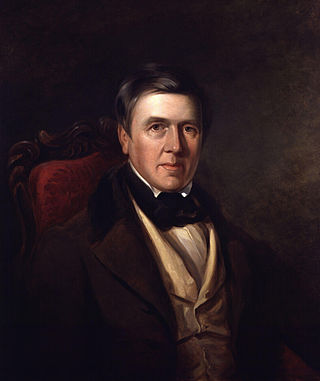
Christoph Ludwig Agricola was a German landscape painter and etcher. He was born and died at Regensburg (Ratisbon).

Impressionism was a 19th-century art movement characterized by relatively small, thin, yet visible brush strokes, open composition, emphasis on accurate depiction of light in its changing qualities, ordinary subject matter, unusual visual angles, and inclusion of movement as a crucial element of human perception and experience. Impressionism originated with a group of Paris-based artists whose independent exhibitions brought them to prominence during the 1870s and 1880s.

Richard Wilson was an influential Welsh landscape painter, who worked in Britain and Italy. With George Lambert he is recognised as a pioneer in British art of landscape for its own sake and was described in the Welsh Academy Encyclopedia of Wales as the "most distinguished painter Wales has ever produced and the first to appreciate the aesthetic possibilities of his country". In December 1768 Wilson became one of the founder-members of the Royal Academy. A catalogue raisonné of the artist's work compiled by Paul Spencer-Longhurst is published by the Paul Mellon Centre for Studies in British Art.

Catherine Greenaway was an English Victorian artist and writer, known for her children's book illustrations. She received her education in graphic design and art between 1858 and 1871 from the Finsbury School of Art, the South Kensington School of Art, the Heatherley School of Art and the Slade School of Fine Art. She began her career designing for the burgeoning holiday card market, producing Christmas and Valentine's cards. In 1879 wood-block engraver and printer, Edmund Evans, printed Under the Window, an instant best-seller, which established her reputation. Her collaboration with Evans continued throughout the 1880s and 1890s.

Watercolor or watercolour, also aquarelle, is a painting method in which the paints are made of pigments suspended in a water-based solution. Watercolor refers to both the medium and the resulting artwork. Aquarelles painted with water-soluble colored ink instead of modern water colors are called aquarellum atramento by experts. However, this term has now tended to pass out of use.

David Cox was an English landscape painter, one of the most important members of the Birmingham School of landscape artists and an early precursor of Impressionism.

Myles Birket Foster was a British illustrator, watercolourist and engraver in the Victorian period. His name is also to be found as Myles Birkett Foster.

Isaac Oliver or Olivier was an English portrait miniature painter.
Events from the year 1840 in art.
Events from the year 1746 in art.
Reginald Jones, R.B.A (1857–1920) was an English landscape painter, who predominantly worked in oil, watercolour and pastel.
Jan Wyck was a Dutch baroque painter, best known for his works on military subjects. There are still over 150 of his works known to be in existence.

William Marlow was an English landscape and marine painter and etcher.
Harriet Gouldsmith was an English landscape painter and etcher.

Walter Frederick Roope Tyndale (1855–1943) was a British watercolourist of landscapes, architecture and street scenes, book illustrator and travel writer.

William Callow (1812–1908) was an English landscape painter, engraver and water colourist.

Robert Brandard was a British landscape engraver and landscapist.

Giles Firmin Phillips (1780–1867) was an English artist and author. He painted landscapes and river scenes, primarily of the river Thames. His paintings were exhibited, among other venues, at the Royal Academy from 1836 - 1858. He is the author of several books on painting and lithography.

Henry Gastineau (1791–1876) was an English engraver and prolific painter in water-colours. He was born in London to a family of Huguenot descent. One of his daughters, Maria Gastineau, painted in a similar style.
Ethelbert White was an English artist and wood engraver. He was an early member of the Society of Wood Engravers and a founding member of the English Wood Engraving Society in 1925. He also worked in oils and water colour. He was a member of the Royal Watercolour Society, and exhibited regularly at the Royal Academy.